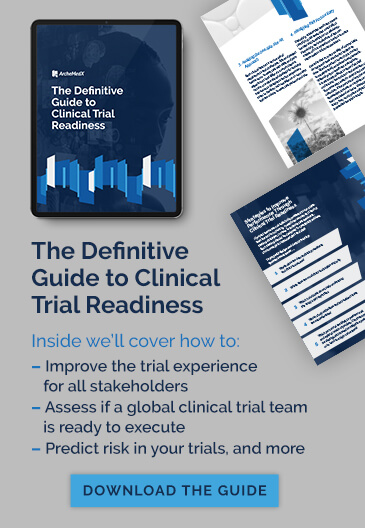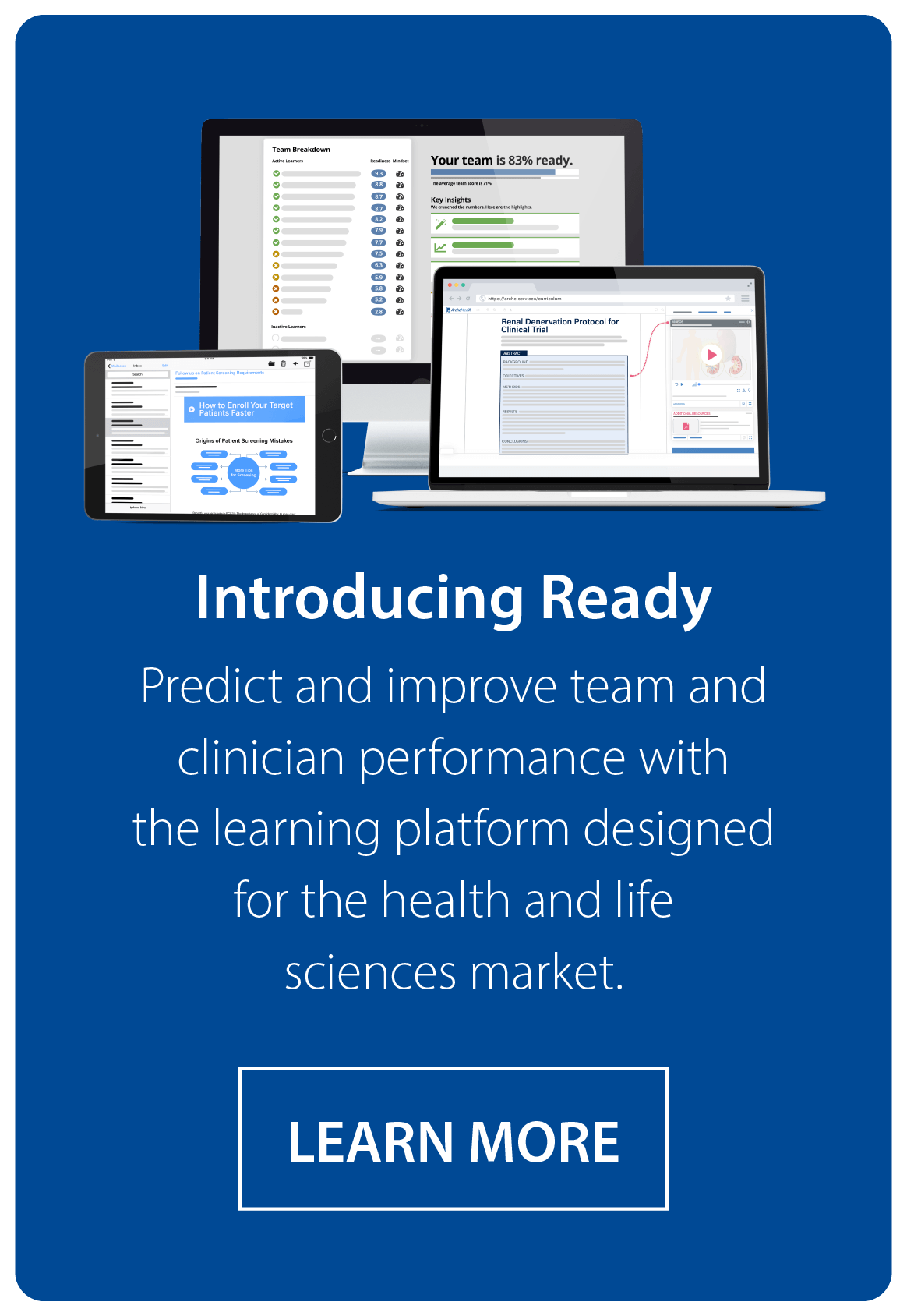Until the recent changes forced upon our industry by COVID-19, clinical research has been anything but digital: instead, relying heavily on in-person interaction, monitoring, and data collection.
Many trials have been forced to halt, or change standard operating procedures (SOPs) in order to restart. The adoption of digital solutions has accelerated. But will these changes remain?
With any change brought about by external forces, there is a risk that some will revert to traditional practices out of familiarity or perceived cost. But there is a huge opportunity to begin down the path of true digital transformation for your clinical teams if you stay the course.
Here we’ll take a look at:
- The benefits of sustained digital transformation
- Investigator meetings
- Site selection and site initiation
- Site training
- Ongoing onboarding
- Patient data collection
What benefits will sustained digital transformation bring to clinical research?
When talking about digital transformation, most executives frame it in one of two ways: as a corporate mandate, or as a vision. Either approach, without action, rings hollow.
In order to push any change in an organization, identifying the business case is truly the first step. So what business outcomes can you expect for more deeply integrating digital solutions within your clinical research programs?
Reduce your costs with digital solutions in clinical research.
The most critical measurement of any business initiative is monetary. It’s also the easiest to quantify. Depending on where you inject a digital solution, the calculation here is easy. The problem is – it is a calculation. This distinction is important, because without calculating the savings that a digital solution provides, all you will see is added cost from licensing and implementation.
For example, if you implement a solution like Ready for an upcoming trial, you should compare that cost to the prior expense of the in-person activities the solution enables you to eliminate, like:
- Location rental/contract fees for large meetings you’ve moved to digital (like investigator meetings)
- Site fees attached to in-person meetings you will no longer pay
- Travel costs related to being onsite for all activities you’re replacing
- Time saved by avoiding travel for every employee/team member involved
Producing this simple, yet critical, component of your business case will make it easy for you to say yes to continuing with any newly adopted digital solution.
Increase patient enrollment with digital solutions in clinical research.
It’s well documented that many trials fail to meet recruitment targets. You’ve seen the stats: As much as 86% of clinical trials do not reach recruitment targets within their specified time periods.
But what if you remove many of the most common barriers to recruitment? Remove burdensome things like travel time, or exposure to external environments (like the pandemic right now).
Or what if you’re able to cast a wider net beyond your site locations by using digital solutions?
Removing the difficulties that patients face, expanding your geographical reach, and making patient education available in a more digital, on-demand format? You may have adopted digital solutions to get through the pandemic for recruitment, monitoring, or patient education – but these are real impacts you can realize by keeping them.
Support diversity in patient recruitment with digital solutions in clinical trials.
Beyond increasing patient enrollment, patient diversity is another powerful outcome you can manifest by continuing with digital processes. By relying on brick-and-mortar site centricity, you limit your enrollment to patient populations who have access, and often who have convenient transportation.
If your organization is committed to diversifying patient populations, then you have to shift to a digital approach. Most effective? Focus on digital recruitment to reach more patients and physicians directly through the many tools and strategies available for outreach. Also prioritize education, and make informed consent more accessible through a digital content tool like Ready.
So where else will you see the biggest impacts in clinical research with digital adoption post-pandemic?
Area #1: Investigator meetings
Investigator meetings (IMs) are prime for disruption. With the average IM series price tag for a global Phase III study approaching upwards of $1 million, there’s a huge amount of cost involved. Could it be realistic to move these meetings – even just some of them – to a digital experience instead?
We performed a survey in the life sciences industry around clinical trials before and after COVID-19 completely changed our world. In that survey so far, 68% of respondents said that their organization believed investigator meetings had to be in person before COVID-19 struck.
But now? Only a paltry 15% today believe investigator meetings need to be in person. Even more compelling, more than 74% of respondents feel that investigator training could be just as effective or more so as a virtual event.
More than 74% of life science professionals feel that investigator training could be just as effective or more so as a virtual event.
It’s clear that the industry already sees investigator meetings as an area where digital is here to stay, and it’s probably because of these reasons:
- Delivering the training virtually saves a huge amount of money (see the above $1 million stat).
- IM planners can measure and assess the actual consumption and mastery of the meeting content when using a digital solution like Ready. Compare this to most in person meetings, where there is no assessment beyond a “present” check mark.
- Even with delays to trial startup, trial teams can continue to review and reinforce their understanding of the protocol when it’s digital, on-demand, and (ideally) able to automatically prompt the team to re-engage.
Area #2: Trial Site Selection and Site Initiation Visits
Yes, these are two different areas. But the differing approaches to site selection, along with the myriad of solutions available for site use and site initiation reveals some overlap in opportunities.
The larger the number of sites you need to manage, the more benefit you will receive by moving anything you can to a digital experience. In fact, 77% of our survey respondents indicate that they’re increasing their use of digital tools with regards to site selection. Similar to investigator meetings, by using digital tools, you increase your ability to more accurately assess consumption and mastery of your trial protocol and processes. So a virtual site selection could be a more accurate, and less time-consuming process.
Even more telling, 84% are increasing their use of digital for site initiation visits. So much of these visits can be moved online, especially for sites that are clearly ready to start. Whether you’re using web meetings to initiate, conference calls, or a full, comprehensive virtual onboarding with Ready or something else, site startup activities are a perfect place to continue with digital solutions.
84% of life science organizations are increasing their use of digital for site initiation visits.
Area #3: Clinical Trial Site Training
Really, any clinical operations area that involves the communication of information like the protocol, amendments, SOPs, or other essential documents is something that you should be moving to digital during this pandemic. Learning does not have to stop!
One of the greatest risks to virtual training, however, is distraction. More so than an in person training, care must be taken to engage learners, focus their attention, and reduce the risk they speed through the content, sharing answers to assessment questions, and multi-tasking. Here are some of the most important things that clients of Ready do to ensure success with this:
- Optimize your training content for a digital experience
- Use assessments that incorporate confidence along with answers
- Create activities and case studies that require team members to apply learnings mid-training

Area #4: Ongoing Team Onboarding and Training
When you joined your current team, what was your onboarding experience like? Was it guided, paced, and targeted to the particulars of your new environment? Or was it like you’d been dropped into the wild west and needed to find your way out?
Particularly for long-term studies, there will always be change in personnel and team members. So plan for it. Make your onboarding documents and process as digital as possible, and organize and prioritize your clinical tools and assets to simplify site and team personnel changes. Your new team members and your sites will thank you.
Area #5: Patient Data Collection via Wearables in Clinical Trials
With the vast adoption of wearables like smart watches and wristbands, there’s a low barrier to adoption for patients. Plus, wearable devices optimize data collection with their sensitivity and widely-tested calibration. Wearables are a fairly mature market, and it’s something we need to adopt more broadly in clinical research, as Kemi Olugemo, M.D. pointed out in a recent conversation with us.
Despite their low adoption in clinical trials, the current time is a perfect way to collect data remotely like walking speed, seizure detection, or perspiration, as examples. Performing diagnostic and biomarker data collection without subjecting trial participants to a visit is vital now, but prudent for a future where we emerge from the pandemic.
Even more promising is the possibility of more accurate and consistent data capture can increase the power of your study. Could that mean fewer participants and accelerating the conduct? Very possible.
Make Digital Solutions a Long Term Focus for Your Clinical Trials
It remains to be seen how much digital change will result in true transformation for our industry. But we know that the steps we take now can pave the way for trials that are less expensive, more accurate, more accessible, and more timely.
Ready by ArcheMedX can help in many of the areas discussed in this blog. So the question is – will your trial team be part of the change now? If so, let us help.





